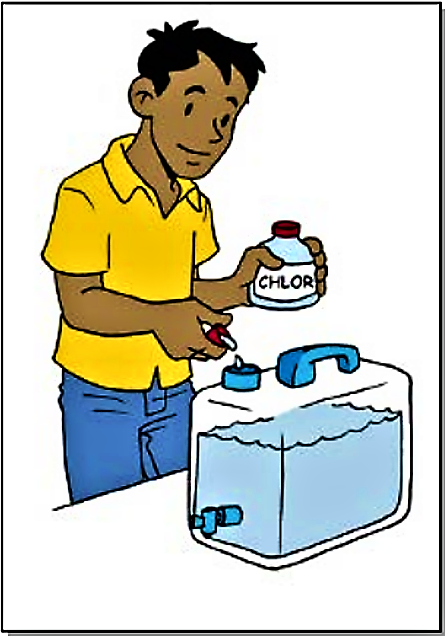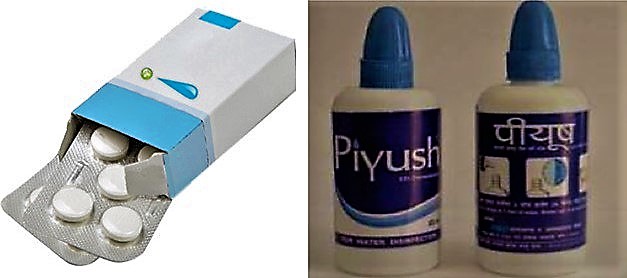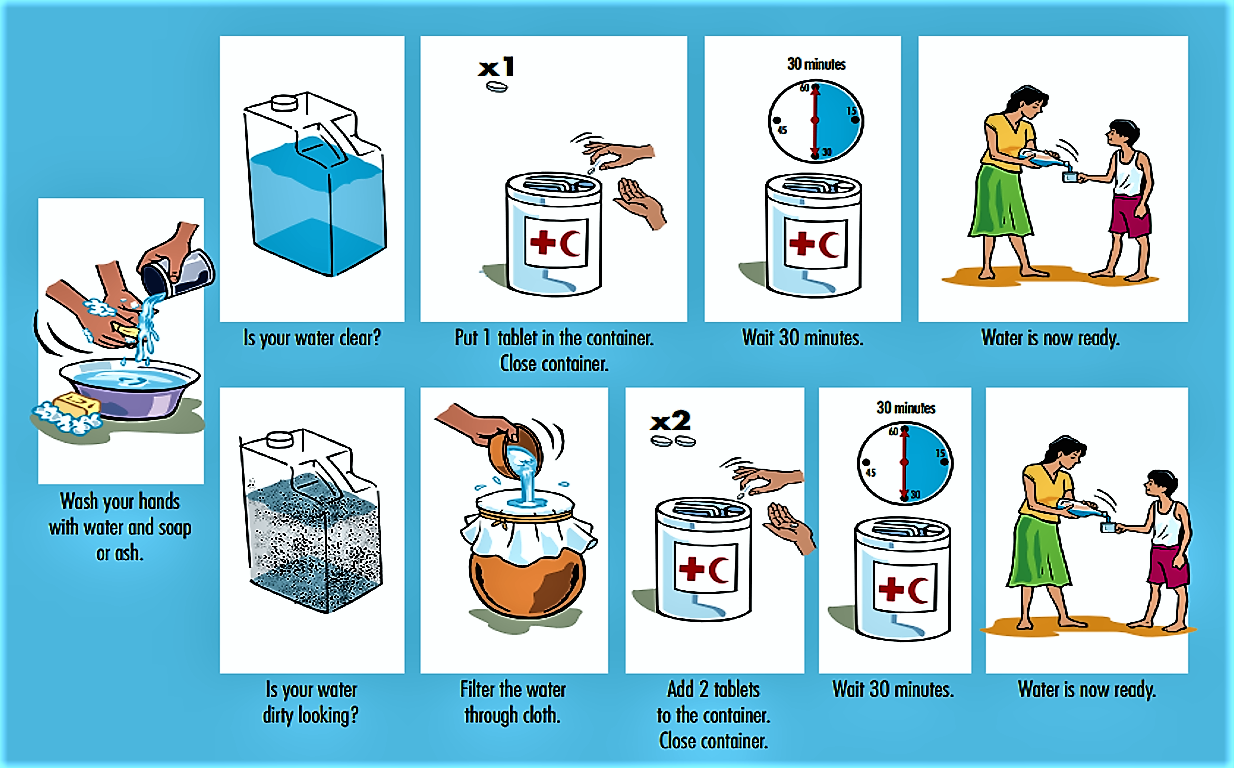Executive Summary
Water disinfection by chlorination was massively introduced in the early twentieth century. It set off a technological revolution in water treatment and complemented the known and used process of filtration. In addition to destroying harmful microorganisms, chlorination also reduces the amount of iron, manganese and hydrogen sulphide in water. Chemical disinfection using chlorine has the benefits of being relatively quick, simple, and cheap and allows a residual amount of chlorine to remain in the water to provide some protection against recontamination.
| In | Out |
|---|---|
Drinking Water |
Introduction

The disinfection of drinking water by adding chlorine is called chlorination. Chlorine was used for the first time in 1850 when John Snow used it in London’s water distribution system to combat cholera. Similarly, American cities like Chicago and New Jersey started to use chlorination around 1908, a step which brought a significant decrease in the number of deaths caused by cholera, typhoid, diarrhoea and hepatitis A. Today, chlorination is used to treat most of drinking water in the world since it is easy, inexpensive and reliable. Chlorine is widely available in different countries with different brand and names.
Chlorination can be achieved by using liquefied chlorine gas, sodium hypochlorite solution or calcium hypochlorite granules and on-site chlorine generators (e.g. WATA). Chlorine is widely applied for the centralised disinfection of drinking water in municipal water supply systems. International agencies have also been promoting chlorination at household level as effective and simple drinking water treatment option in developing countries.
Chlorine as a household level point of use treatment is available either a solution which is added at doses of one to several drops per litre of water to treat, or as tablets, which will dissolve in the treated water. Aside from these commercial products, water can also be treated at the community level by mixing chlorine in water tanks, wells and household vessels.
How does it work?
When chlorine is added to water, the chemical element dissolves and forms radicals. These kill pathogens such as bacteria and viruses by breaking the chemical bonds in their molecules or by attacking the cells of the microorganisms. The different radicals and ions formed during chlorination destroy many bacteria and viruses, but also oxidise some organic matter, dissolve colours and destroy chloramines, toxic products derived from ammonia. It takes about 30 minutes to do this work and make water safe to drink.

Use of chlorine
The correct amount of chlorine solution must be used. If the concentration of chlorine is inadequate the solution may fail to destroy all the harmful micro-organisms and if in excess, health may be adversely affected. Only an appropriate amount of chlorine can destroy most of harmful micro-organisms and provide a safe amount of residual chlorine. Chlorine that does not combine with other components and remains in the water is called “Free Residual Chlorine” (FRC). FRC makes sure that water which has been treated by chlorination will not get recontaminated when being transported or stored. According to WHO guidelines, the FRC concentration in drinking water should be between 0.2 to 0.5 mg/L.
Effectiveness
| Very Effective For: | Somewhat Effective For: | Not Effective For: |
|
|
Effectiveness of the Chlorination. Source: CAWST (2009)
Chlorine disinfection of drinking water is limited for the protozoan pathogens (in particular cryptosporidium) and some viruses (WHO 1996). Turbidity can protect microorganisms from disinfection. Further, when the natural organic matter (NOM) of the water is high, this can lead to the formation of disinfection by-products (DBPs) such as halogenated organic molecules, mainly trihalomethanes (THM), some of which are potentially hazardous. However, the risks to health from these by-products are extremely small in comparison with the risks associated with inadequate disinfection, and disinfection should not be compromised in attempting to control DBPs (WHO 1996; WHO 2006).
In 1991, the International Agency for Research on Cancer evaluated the carcinogenic potential of chlorinated drinking water. IARC concluded, that „there is inadequate evidence for the carcinogenicity of chlorinated drinking-water in humans“. However, for water containing large amounts of organics, the formation of carcinogenic halogenated disinfection products derived from the organic matter attacked by the chlorine is extremely high – it is therefore recommended to use pre-filtration (e.g. slow sand filtration or bio-sand filtration).

Chlorination is very suitable for places where people are directly drinking water from bacterial contaminated water sources but where other contamination (e.g. natural organic matter, arsenic) are not of concern.
It is socially acceptable by general public for purifying water because of easy handling, cost effectiveness as well as good removal of microbial organism in drinking water. It is most commonly used for water disinfection during emergencies (IFRC 2008; CDC/USAID 2008; WHO n.y.). However, a constant supply of chlorine must be guaranteed.
Filtration & Chlorination Systems
Introduction to filtration and chlorination systems at the household level.
CDC/USAID (2009): Filtration & Chlorination Systems . (= CDC Household Water Treatment Options in Developing Countries Factsheets ). New York: Center for Disease Control and Prevention (CDC) and United States Agency for International Development (USAID). [Accessed: 01.04.2010] PDFChlorine in water disinfection
This article contains information on safe drinking water, and explains the benefits and risks of chlorination.
GORCHEV, G.H. (1996): Chlorine in water disinfection. In: Pure & Applied Chemistry: Volume 68 , 1731-1735. URL [Accessed: 19.05.2010]IARC monographs on the evaluation of carcinogenic risks to humans. Chlorinated drinking-water; chlorination by-products; some other halogenated compounds; cobalt and cobalt compounds
Household water treatment and safe storage in emergencies
This document is intended as a general manual on household water treatment and storage in emergencies. Methods of treatment but also promotion are presented, including factsheets, a decision tree and very comprehensive illustrations.
IFRC (2008): Household water treatment and safe storage in emergencies. pdf presentation. Geneva: International Federation of Red Cross and Red Crescent Societies (IFRC) URL [Accessed: 23.04.2012]Household Water Treatment and Safe Storage Following Emergencies and Disasters
A six-pages compilation about what to do in emergency situations. Designated to the South Asia earthquake and tsunami.
WHO (n.y): Household Water Treatment and Safe Storage Following Emergencies and Disasters. pdf presentation. Geneva: World Health Organisation (WHO) URL [Accessed: 17.05.2019]Guidelines for Drinking-Water Quality, Second Edition
This volume of the WHO guidelines for drinking-water quality explains how guideline values for drinking-water contaminants are to be used, defines the criteria used to select the various chemical, physical, microbiological, and radiological contaminants included in the report, describes the approaches used in deriving guideline values, and presents, in the form of brief monographs, critical reviews and evaluations of the effects on human health of the substances or contaminants examined.
WHO (1996): Guidelines for Drinking-Water Quality, Second Edition. (= Health Criteria and Other Supporting Information - Second Edition , 2 ). Geneva: World Health Organization (WHO) URL [Accessed: 31.03.2010]Guidelines for Drinking-water Quality. FIRST ADDENDUM TO THIRD EDITION
This volume of the Guidelines for Drinking-water Quality explains requirements to ensure drinking-water safety, including minimum procedures and specific guideline values, and how those requirements are intended to be used. The volume also describes the approaches used in deriving the guidelines, including guideline values. It also includes fact sheets on significant microbial and chemical hazards.
WHO (2006): Guidelines for Drinking-water Quality. FIRST ADDENDUM TO THIRD EDITION. Geneva: World Health Organization (WHO) URL [Accessed: 19.01.2011]Disinfecting your well water: Shock Chlorination, Housing and Environment
This article describes how to use shock chlorination safely and effectively.
ATILES, J.H. VENDRELL, P.F. (2003): Disinfecting your well water: Shock Chlorination, Housing and Environment. Georgia: The University of Georgia URL [Accessed: 19.05.2019]AUTARCON SuMeWa System
Powerpoint presentation of the water purification system implied by AUTARCON. This system uses solar energy to realise mechanical filtration and chlorification of water.
AUTARCON (2012): AUTARCON SuMeWa System. SolarPV Driven-Drinking Water Treatment. Munich: AUTARCON, Sun Meets Water (SuMeWa) System. [Accessed: 18.07.2017] PDFChlorine (NaDCC Tablets)
Factsheet on chlorination with NaDCC tablets.
CAWST (2009): Chlorine (NaDCC Tablets). (= Household Water Treatment and Safe Storage Fact Sheets – Academic ). Alberta: Center for Affordable Water and Sanitation Technology (CAWST) URL [Accessed: 19.05.2019]Chlorine (Sodium Hypochlorite)
Factsheet on chlorination with sodium hypochlorite solutions.
CAWST (2009): Chlorine (Sodium Hypochlorite). (= Household Water Treatment and Safe Storage Fact Sheets – Academic ). Alberta: Center for Affordable Water and Sanitation Technology (CAWST) URL [Accessed: 19.05.2019]Household Water Treatment Options in Developing Countries: Household Chlorination
HWTS factsheets
Compilation of factsheets on water quality in general and description of different HWTS options such as chlorination, colloidal silver filters, biosand filter, chlorination and SODIS.
DWSS (2007): HWTS factsheets. Department of Water Supply and Sewerage (DWSS) Nepal, United States Agency for International Development (USAID), United Nations Human Settlements Programme (UN-HABITAT), United Nations Children's Fund (UNICEF)Chlorination
A 16-page factsheet providing information on water quality and household water treatment options. It contains an introductory section, and one on use, advantages, chlorine preparation and chlorination in Nepal.
DWSS (2009): Chlorination. (= Household Water Treatment options Fact Sheet , 6 ). DWSS, UNICEF, UN-HABITAT, USAID & ENPHOChlorine in water disinfection
This article contains information on safe drinking water, and explains the benefits and risks of chlorination.
GORCHEV, G.H. (1996): Chlorine in water disinfection. In: Pure & Applied Chemistry: Volume 68 , 1731-1735. URL [Accessed: 19.05.2010]Challenges to the Commercial Viability of Point-of-Use (POU) Water Treatment Systems in Low-Income Settings
This dissertation investigates the commercial viability of point-of-use (POU) water treatment systems (solar treatment, physical treatment and chemical treatment) in lower income settings. Six factors that have helped POU projects approach commercial viability are highlighted, including refining and improving product positioning, leveraging existing health awareness, offering an array of POU options, adapting business practices, finding alternative models of viability, and focusing on key product improvements.
HARRIS, J. (2005): Challenges to the Commercial Viability of Point-of-Use (POU) Water Treatment Systems in Low-Income Settings. Master Thesis. Oxford School of Geography and the Environment Oxford University URL [Accessed: 19.05.2019]Smart Disinfection Solutions
This booklet, part of the Smart Water Solutions series provides a wide range of methods and products for home water treatment in rural areas.
NWP (2010): Smart Disinfection Solutions. Examples of small-scale disinfection products for safe drinking water. (= Smart water solutions ). Amsterdam: KIT Publishers URL [Accessed: 17.05.2019]Shock Chlorination for Private Water Systems
This paper provides detail information on shock chlorination. It is also available at www.oznet.ksu.edu
POWELL, M ROGERS, D.H. WILLINGHAM, J.M. (2005): Shock Chlorination for Private Water Systems. Kansas State University URL [Accessed: 19.05.2019]UNICEF Handbook on Water Quality
This handbook is a comprehensive a new tool to help UNICEF WASH field professionals, but it will also be useful to other UNICEF staff and for partners in government, other external support agencies, NGOs and civil society. The handbook provides an introduction to all aspects of water quality, with a particular focus on the areas most relevant to professionals working in developing countries. It covers the effects of poor water quality, quality monitoring, the protection of water supplies, methods for improving water quality, and building awareness and capacity related to water quality.
UNICEF (2008): UNICEF Handbook on Water Quality. New York: United Nations Children's Fund (UNICEF) URL [Accessed: 19.05.2019]Gender In Water Resource Management Supply and Sanitation. Roles and Realities Revisited
This book investigates how gender is present in the newly emerging principles on the sustainable management of water resources. The book also reviews how these gender specific principles are currently applied in the water supply, sanitation and hygiene sector.
WIJK-SIJBESMA, C. van (1998): Gender In Water Resource Management Supply and Sanitation. Roles and Realities Revisited. The Hague: International Water and Sanitation Centre (IRC) URL [Accessed: 19.05.2019]Chlorine in Drinking-water. Background document for development of WHO Guidelines for Drinking-water Quality
This document contains a general description of chlorine, guideline values, researches effects on laboratory animals and investigates potential human health risks.
WHO (2003): Chlorine in Drinking-water. Background document for development of WHO Guidelines for Drinking-water Quality. Geneva: World Health OrganizationGuidelines for Drinking-water Quality, Third Edition
This volume of the Guidelines for Drinking-water Quality explains requirements to ensure drinking-water safety, including minimum procedures and specific guideline values, and how those requirements are intended to be used. The volume also describes the approaches used in deriving the guidelines, including guideline values. It includes fact sheets on significant microbial and chemical hazards.
WHO (2008): Guidelines for Drinking-water Quality, Third Edition. Third Edition incorporating the First and Second Addenda. Geneva: World Health Organization (WHO) URL [Accessed: 23.04.2012]Guidelines for Drinking-water Quality, Fourth Edition
This volume of the Guidelines for Drinking-water Quality explains requirements to ensure drinking-water safety, including minimum procedures and specific guideline values, and how those requirements are intended to be used. The volume also describes the approaches used in deriving the guidelines, including guideline values. It includes fact sheets on significant microbial and chemical hazards.
WHO (EDITOR) (2011): Guidelines for Drinking-water Quality, Fourth Edition. Geneva: World Health Organization (WHO) URL [Accessed: 11.07.2018]Source Book of Alternative Technologies for Freshwater Augmentation in Latin America and the Caribbean
The Latin American and Caribbean countries have seen growing pressure on water resources, with increasing demand and costs, for agricultural, domestic and industrial consumption. This has brought about the need to maximize and augment the use of existing or unexploited sources of freshwater. There are many modern and traditional alternative technologies for improving the utility and augmenting the supply of water being employed in various countries, but with limited application elsewhere due to the lack of information transfer among water resources managers and planners. This book was prepared to provide water resource managers and planners, especially in developing countries and in countries with economies in transition, with information on the range of technologies that have been developed and used in the various countries throughout the world.
UNEP (1998): Source Book of Alternative Technologies for Freshwater Augmentation in Latin America and the Caribbean. Nairobi: United Nations Environment Programme (UNEP) URL [Accessed: 17.10.2011]Conservation et Traitement de l Eau a Domicile
This practical guide provides a review of different processing techniques and adequate water conservation at home and is structured around 10 key questions that should be posed before choosing a suitable solution.
DESILLE, D. (2013): Conservation et Traitement de l Eau a Domicile. Paris: Programme Solidarite Eau (PSeau) URL [Accessed: 06.06.2013]Preventing Diarrhoea Following a Flood Emergency: An Evaluation of Home-based Chlorination
Safe Water Systems: An Evaluation of the Zambian CLORIN Program
This evaluation report provides the findings and key lessons learnt from assessment study conducted in Zambia for the use of chlorine solution.
OLEMBO, L. FAD, K. TUBA, M. BURNHAM, G. (2004): Safe Water Systems: An Evaluation of the Zambian CLORIN Program . URL [Accessed: 31.05.2010]Promotion of household water treatment and safe storage in UNICEF WASH programmes
Short introduction to household water treatment and the main treatment methods.
UNICEF (2008): Promotion of household water treatment and safe storage in UNICEF WASH programmes. pdf presentation. New York: United Nations Children's Fund URL [Accessed: 17.03.2010]Nepal’s Experiences in Community-Based Water Resource Management
This paper documents WAN and its partners’ work on community-based approaches to water resource management, and attempts to distil important lessons from their experience to inform continued refinement of WAN’s institutional approach to CWRM and inform sector learning.
WAN (2008): Nepal’s Experiences in Community-Based Water Resource Management. (= Fieldwork paper ). Water Aid Nepal (WAN) and End Water Poverty URL [Accessed: 30.03.2010] PDFPV Meets Drinking Water
This article describes the practicability of a water purification system which is not reliant on batteries but on solar radiation.
WIDMAN, M. (2011): PV Meets Drinking Water. In: pv magazine: Volume 12 URL [Accessed: 16.07.2012]Linking Technology Choice with Operation and Maintenance in the context of community water supply and sanitation. A reference Document for Planners and Project Staff
This document is addressed to planners and staff of water supply and sanitation projects on household and community level. The reader is guided through the main steps of informed choices regarding the main proven technologies for water supply, purification and water treatment at household and community level. Each technology is described in a small factsheet, regarding its functioning, actors and their roles, the main operation and maintenance (O&M) requirements and problems, which can occur.
BRIKKE, F. BREDERO, M. (2003): Linking Technology Choice with Operation and Maintenance in the context of community water supply and sanitation. A reference Document for Planners and Project Staff. Geneva: World Health Organization and IRC Water and Sanitation Centre URL [Accessed: 03.06.2018] PDFChlorine (NaDCC Tablets)
Factsheet on chlorination with NaDCC tablets.
CAWST (2009): Chlorine (NaDCC Tablets). (= Household Water Treatment and Safe Storage Fact Sheets – Academic ). Alberta: Center for Affordable Water and Sanitation Technology (CAWST) URL [Accessed: 19.05.2019]Chlorine (Sodium Hypochlorite)
Factsheet on chlorination with sodium hypochlorite solutions.
CAWST (2009): Chlorine (Sodium Hypochlorite). (= Household Water Treatment and Safe Storage Fact Sheets – Academic ). Alberta: Center for Affordable Water and Sanitation Technology (CAWST) URL [Accessed: 19.05.2019]HWTS training guideline
This training manual provides information on various household drinking water treatment options. Each description contains an introduction to the technology, its working mechanism, costs, advantages and limitations (Nepali).
DWSS (2008): HWTS training guideline. Nepal: Department of Water Supply and Sewerage (DWSS)Food and Water in an Emergency
This booklet should support households to prepare them for emergency situation by storing emergency food and water supplies.
FEMA (2004): Food and Water in an Emergency. Federal Emergency Management Agency (FEMA), U.S. Department of Homeland Security and American Red Cross URL [Accessed: 30.03.2010]Household water treatment and safe storage in emergencies
This document is intended as a general manual on household water treatment and storage in emergencies. Methods of treatment but also promotion are presented, including factsheets, a decision tree and very comprehensive illustrations.
IFRC (2008): Household water treatment and safe storage in emergencies. pdf presentation. Geneva: International Federation of Red Cross and Red Crescent Societies (IFRC) URL [Accessed: 23.04.2012]Household Water Treatment and Safe Storage Following Emergencies and Disasters
A six-pages compilation about what to do in emergency situations. Designated to the South Asia earthquake and tsunami.
WHO (n.y): Household Water Treatment and Safe Storage Following Emergencies and Disasters. pdf presentation. Geneva: World Health Organisation (WHO) URL [Accessed: 17.05.2019]How to measure chlorine residual in water
Many of the most common diseases found in traumatized communities after a disaster or emergency are related to drinking contaminated water. This factsheet concentrates on the problems caused by drinking water contaminated by micro-organisms and their reduction by chlorination.
WHO (2005): How to measure chlorine residual in water. (= Technical Notes for Emergencies , 11 ). Geneva: World Health Organization (WHO) URL [Accessed: 19.05.2019]Filtration & Chlorination Systems
Introduction to filtration and chlorination systems at the household level.
CDC/USAID (2009): Filtration & Chlorination Systems . (= CDC Household Water Treatment Options in Developing Countries Factsheets ). New York: Center for Disease Control and Prevention (CDC) and United States Agency for International Development (USAID). [Accessed: 01.04.2010] PDFPreventing Diarrhoeal Disease in Developing Countries: Proven Household Water Treatment Options
One-page introduction to main household water treatments methods, and further reading links.
CDC/USAID (2008): Preventing Diarrhoeal Disease in Developing Countries: Proven Household Water Treatment Options. Atlanta and New York: Center for Disease Control and Prevention (CDC) and United States Agency for International Development (USAID) URL [Accessed: 15.03.2010]Household Water Treatment Options in Developing Countries: Household Chlorination
Flip Chart on HWTS
Amoeba and Water
This children’s book provides information on safe drinking water, ways of water contamination, simple HWTS options presented in attractive illustrations and simple languages so that school children can easily understand them.
ENPHO (2007): Amoeba and Water. Kathmandu and New York: Environment and Public Health Organization (ENPHO) and United Nations Children's Fund (UNICEF) URL [Accessed: 19.05.2019]Promotion of household water treatment and safe storage in UNICEF WASH programmes
Short introduction to household water treatment and the main treatment methods.
UNICEF (2008): Promotion of household water treatment and safe storage in UNICEF WASH programmes. pdf presentation. New York: United Nations Children's Fund URL [Accessed: 17.03.2010]Combating Waterborne Diseases at the Household Level
This document is divided into three main parts. The first part contains an introduction to the topic and depicts some possible, simple techniques for treating water at the household level. The second part describes the possibility of collaborating to fight against waterborne diseases and the last part presents again some low-cost solutions.
WHO (2007): Combating Waterborne Diseases at the Household Level. The International Network to Promote Household Water Treatment and Safe Storage. Geneva: World Health Organisation (WHO) URL [Accessed: 11.10.2010]Chlorination
This weblink contains different and useful reading materials on water chlorination, shock chlorination, tablet chlorination etc.
Disinfectants - Chlorine
This web link provides different important facts of chlorine along with methods of chlorine production, information on the disinfection process etc.
Emergency Disinfection of Drinking Water
Factsheet on emergency drinking water disinfection from the U.S. Environmental Protection Agency (U.S. EPA). The factsheets can be downloaded as PDF in English, Spanish, French, Arabic and Vietnamese.
Chlorination of Drinking Water
Short introduction on technical and practical aspects of chlorination.


